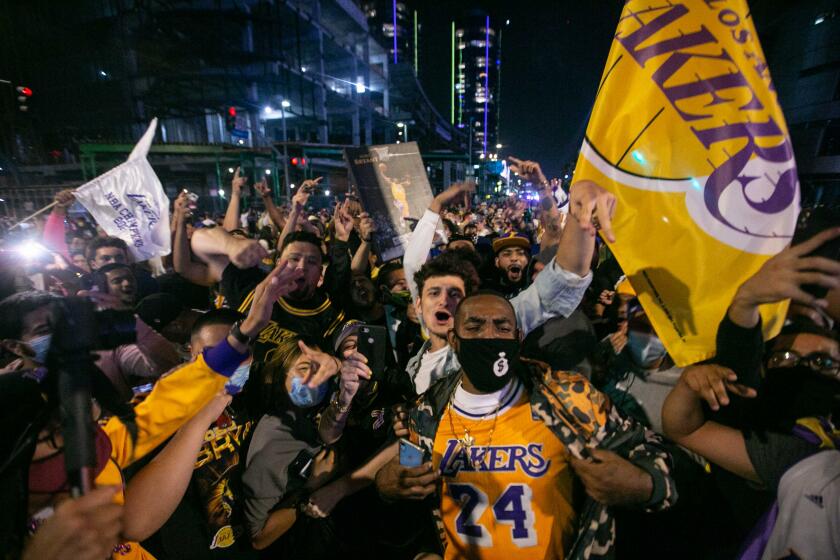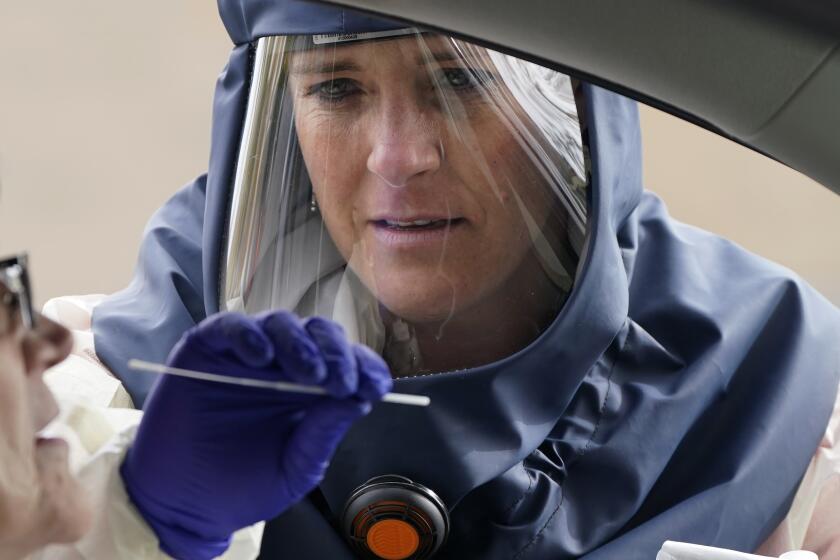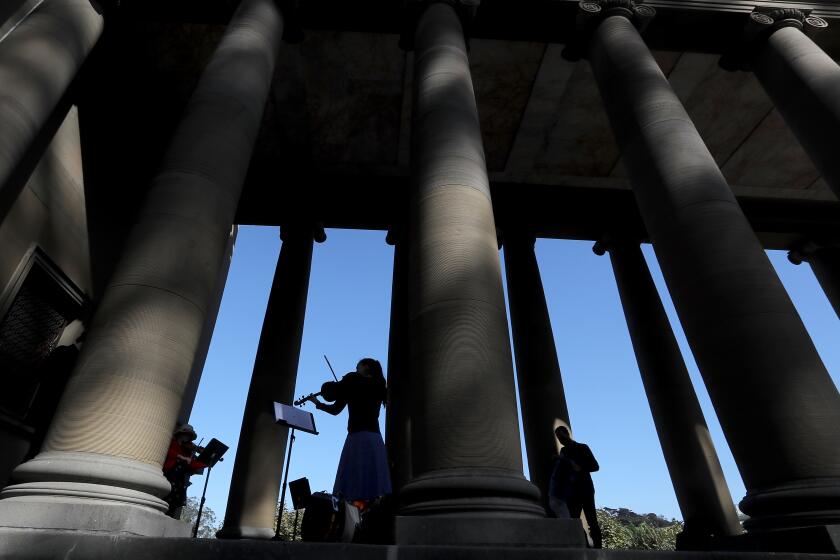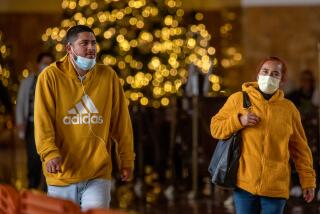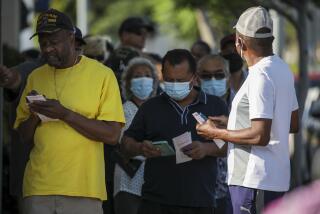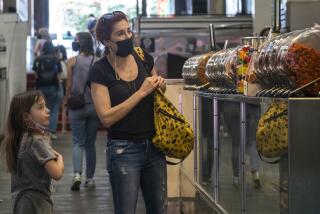L.A. County hits new milestones in coronavirus cases, deaths amid troubling increase in infections
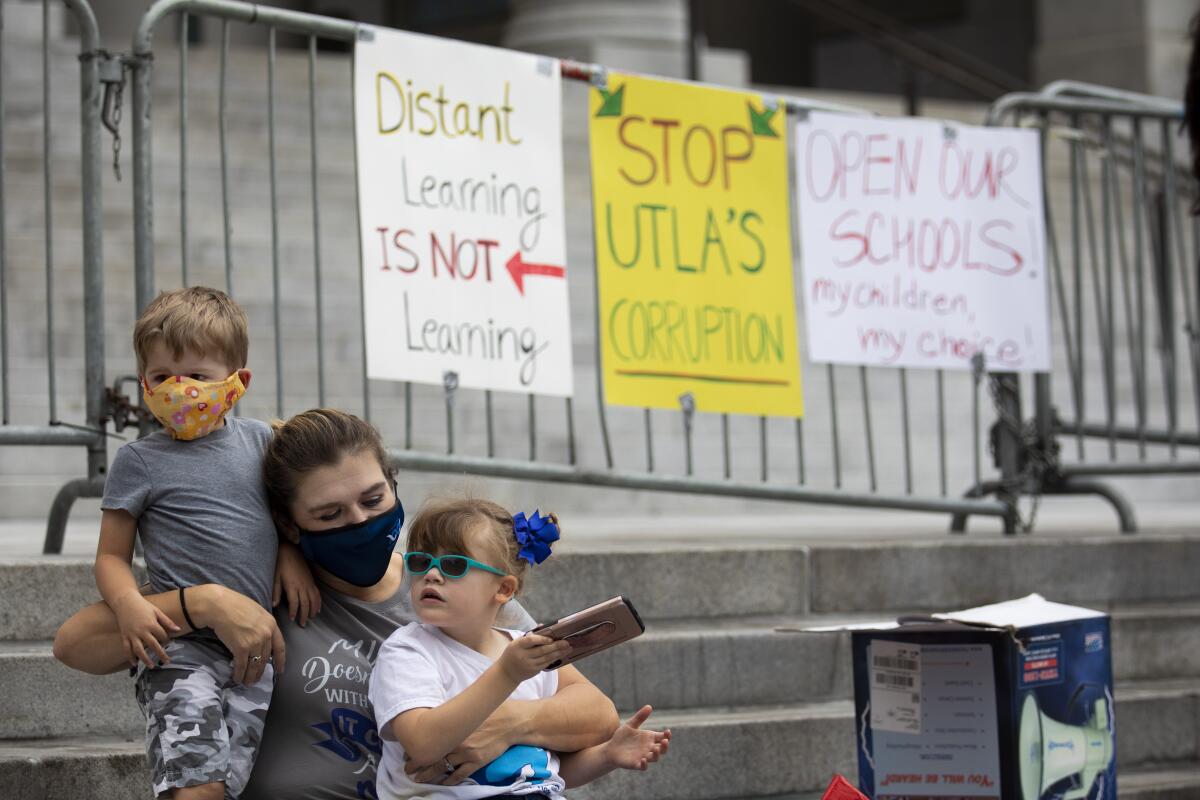
- Share via
Los Angeles County on Monday reached two unwelcome milestones in its fight against the novel coronavirus: 300,000 cases and 7,000 deaths.
The magnitude of those figures, officials say, reinforces the importance of continued caution in the face of a pandemic that is surging in many parts of the country and locally has made a worrying upward turn.
While recent increases in the number of cases in L.A. County have not been as steep as those seen over the summer, when coronavirus infections, hospitalizations and deaths shot to new heights throughout the state, they are nevertheless “a cause for concern,” public health director Barbara Ferrer said Monday.
The rise — which has seen the daily average number of new cases grow from under 1,000 in early October to almost 1,200 as of last week — is the result “of decisions we collectively made two to three weeks ago, and the action we’re taking today will influence whether we continue our recovery journey, we stall, or we step backward,” she said during a briefing.
“If you’ve eased up over the past few weeks as there are more opportunities for interacting with others, it’s time to go back to being extremely careful,” she said.
The county reported 830 new COVID-19 cases Sunday and another 861 on Monday, which pushed the total number of people infected past 300,000. Eight new fatalities raised the death toll to 7,000.
The number of deaths, Ferrer said, is “a grim reminder of the horrific impact COVID-19 has had on so many of our families.”
Though the daily case totals announced Sunday and Monday offered a reprieve from a three-day run of high positive case counts that were the result of a backlog caused by technical problems with the state’s computer tracking system, officials warned the low figures are at least partly the result of weekend reporting delays.
There has been an overall uptick recently in the local number of hospitalized COVID-19 patients — from 722 on Oct. 19 to 767 as of Monday — though that figure remains substantially below the peak seen during the summer’s coronavirus surge.
Ferrer said one likely culprit for the recent increase in cases is people easing up on the precautions they have been taking, socializing with people outside their immediate family and not doing so safely.
In particular, this could be the case, she said, if people are coming together to cheer on local sports teams like the Lakers, who recently won the NBA title, or the Dodgers, who are hoping to secure the World Series crown this week.
Fan exuberance — howling in joy or despair, hugging or high-fiving complete strangers, staying in close proximity with others for an hours-long broadcast — runs counter to the safety guidelines to prevent the spread of the virus.
“I think it’s really wonderful that we have both incredible teams with so much talent and also incredible spirit amongst people in L.A. County who root with their hearts and their souls for their teams to do well,” Ferrer said. “The downside of this is, during a pandemic, some of the things we’ve done in the past just don’t make sense.”
Officials stressed that the disease can strike any age group and that personal decisions on adhering to prevention measures will dictate when the county can further lift restrictions on businesses and public facilities.
California as a whole surpassed 900,000 confirmed cases of the virus over the weekend. More than 17,300 people have died statewide, according to The Times’ coronavirus tracker.
Though the state’s overall number of cases and deaths continues to be among the highest in the nation — not surprising, given it is by far the most populous state — California has, to this point, seemingly avoided the significant surge currently striking many other parts of the country.
The U.S. on Sunday reached a new high for the average number of new cases over a seven-day period with 68,954, according to the COVID Tracking Project. The tally surpassed a previous peak of cases that came in July.
About half of states in the U.S. have seen their highest daily infection numbers at some point in October, and the country as a whole came very close to back-to-back record daily infection rates on Friday and Saturday.
As of Monday morning, there had been more than 8.6 million total confirmed infections in the U.S., according to the Johns Hopkins Coronavirus Resource Center. More than 225,000 Americans have died.
It’s not just the United States that’s wrestling with renewed outbreaks. Nations across Europe are enacting more sweeping restrictions to try to slow surging infection rates as a long-feared winter wave of the coronavirus seems to be materializing.
About half of U.S. states have seen their highest daily coronavirus infection numbers so far at some point in October, and the country as a whole came very close to back-to-back record daily infection rates on Friday and Saturday
It’s amid this landscape that California health officials find themselves trying to strike a delicate balance between further reopening sections of the state’s battered economy and staving off a significant surge.
The state has implemented a color-coded, four-tier reopening road map, which relies on new case and testing positivity rates to determine how widely individual counties can reopen businesses and other communal spaces.
L.A. is one of 12 counties currently placed in the most restrictive Tier 1, also known as the purple tier, which indicates widespread risk of community coronavirus transmission.
For the counties in that category — which include San Bernardino, Imperial and Riverside in Southern California — many businesses and public facilities either cannot operate indoors or can do so only at a strictly limited capacity.
By comparison, only nine of the state’s 58 counties are in Tier 4 — the least restrictive “yellow” tier — of the reopening plan. Those counties, which as of last week include San Francisco, can resume most business operations with modifications.
San Francisco shut down early in the pandemic and later limited reopening. Now the city is the first urban center in California where the risk of infection is rated as minimal.
In Riverside County, which slid back to the purple tier just last week, officials stressed that residents need to follow safety measures like regular handwashing, maintaining physical distancing and wearing masks in public.
Getting tested for the coronavirus is also an important tool to help stymie the spread and get the county moving back in the right direction, the officials said.
“If you’re medically vulnerable, detecting the infection early might reduce your risk of complications and, even if you’re well, it means you can take precautions sooner to avoid spreading it to your family or workplace,” county public health officer Dr. Cameron Kaiser said in a statement. “If we can get less spread, fewer people will be at risk, and that’s the most important goal.”
Still, even though a broad reopening remains off the table for now in L.A. County, officials have relaxed some coronavirus-related restrictions recently.
Last week, the county revised the local health order to permit personal care services such as massage and tattoo parlors to resume modified indoor operations, eliminate a requirement that customers at wineries and breweries make reservations, remove the food service requirement for wineries, and allow family entertainment centers to reopen outdoor attractions such as go-kart tracks, miniature golf courses and batting cages.
County schools also will be permitted to bring 25% of their students back to campus at a time, provided they need special services best offered in person.
Officials have “learned a lot” about balancing reopening with safety over the past few months, Ferrer said, and “we’ve been much more deliberate” about making sure businesses are complying with COVID-19 protocols.
Still, though, she stressed that personal decisions will continue to play a key role in determining whether the county progresses or regresses in its recovery journey.
“If everybody was wearing their face covering and everybody was keeping their distance, we’d be moving a lot quicker through our tiers,” she said.
“If that’s what it takes to get our schools reopened and that’s what it takes to keep people at work,” she added, “I think that’s a small price to pay right now.”
The Associated Press contributed to this report.
More to Read
Sign up for Essential California
The most important California stories and recommendations in your inbox every morning.
You may occasionally receive promotional content from the Los Angeles Times.
